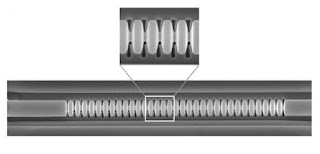 |
| Electron microscope image of the optical cavity used to make a quantum memory. Each segment in the cavity has a vertical dimension of about 690 nm (Courtesy: Tian Zhong et al / Science) |
A new type of optical quantum memory that could be integrated with other components on a chip has been unveiled by physicists in the US. The device overcomes an important challenge facing researchers trying to make quantum computers based on light – how to efficiently capture a photon within a sub-micron-sized structure.
From sending messages that could never be bugged to linking together quantum computers in a "quantum Internet", the ability to exchange quantum information may be vital to the future of technology. This will not be possible, however, without quantum memories to store quantum states and release them when needed.
In the Internet of today, information is sent between computers through a distributed series of nodes called routers. "Packets [of information] are maybe stored for some time and then they are sent," says Andrei Faraon of the California Institute of Technology, "There is some control over the timing of the packet." An optical network that uses photons to carry quantum information would require analogous nodes to store not strings of ones and zeroes (bits) but the full quantum states of individual photons (quantum bits or qubits).
There are currently several different quantum memories under development – some storing qubits as collective excitations in ensembles of atoms, others using solid-state crystals. Among the second group, crystals doped with ions of rare-earth metals have proved successful because rare-earth ions have sharp, stable electronic transitions that can couple to photons and preserve their quantum states. However, absorbing a photon generally requires millimetre- to centimetre-thicknesses of material, making quantum memories rather large.
Optical quantum memory shrinks to the nanoscale, Tim Wogan, Physics World
Comments